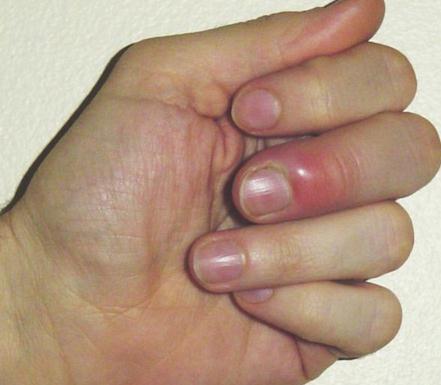Swollen Fingers Causes, Symptoms and Treatment
What are Swollen Fingers?
A swollen finger is a medical sign of inflammation or fluid build-up in the joints or tissues that are located in a person’s finger. The fingers are one of the common body parts that tend to be overused. Hence, they are not given significant attention unless they become swollen. When a person has swollen fingers, he or she will not be able to perform their normal or day-to-day activities like holding, eating, and touching.

Swollen Fingers Causes
The etiological factors that cause swollen fingers are as follows:
- Autoimmune, degenerative, inflammatory, and infectious etiological factors include:
- Carpal tunnel syndrome
- Infections like streptococcus aureus infection
- Osteoarthritis
- Septic arthritis
- Rheumatoid arthritis
- Paronychia
- Ganglion cyst
- Cellulitis (bacterial skin infection)
- Bursitis (inflammation of the bursa)
- Herpetic withlow
- Injury etiological factors include:
- Repetitive stress injury
- Cartilage or ligament injury
- Broken bones
- Blunt or laceration of the bone
When one has one of the etiological factors mentioned above, he or she will experience the condition called swollen fingers. The complications that are associated with swollen finger condition include finger deformity, surgical repair damage, spread of infection to nearby areas, inability o perform normal day-to-day tasks, finger amputation, and chronic form of disability.
Swollen Fingers Associated Symptoms
When a person has a swollen finger, he or she may have an underlying disease condition that needs to be checked immediately. Such condition includes infections which may be accompanied by chills, redness, warmth, and fever. Other associated symptoms that may be experienced include the following:
- Fatigue
- Bluish discoloration
- Pain
- Stiffness
- Decreased movement or motion
- Pus-filled cracks
- Laceration
- Lumps on fingers
- Swelling of the joints
Swollen Fingers Treatment
There are two suggested treatments for a person with swollen fingers. The first one uses the acronym RICE, and the other is a home remedy treatment.
RICE
The medically accepted acronym RICE stands for:
- Rest
- Ice
- Compression
- Elevation
First, the affected finger needs to rest, and ice compression is applied for at least ten minutes to the swollen area. Next, a bandage or tape is applied to cover and wrap the swollen finger but not too tightly to allow blood circulation. Lastly, the affected area needs to be elevated, e.g., to have it in an upright position. This method should be repeated until the swollen area gets better.
Home Remedies
Another treatment option for swollen fingers is home remedy treatment which includes the following:
Garlic
Garlic has a substance that is called allicin, which is known to assist a person’s immune system wherein it suppresses microorganism reproduction and growth. In the home remedy treatment, 2-3 gloves of garlic are combined with mustard oil in a small bowl, and the mixture is heated. Once the heated mixture has cooled down, the oil is applied to the swollen finger and left on the finger for an hour or so. The procedure is repeated at least 4-5 times to get instant relief.
Turmeric
Turmeric is known to be a natural kind of antiseptic herb powder with healing properties. Its function is to kill bacteria that causes pain and inflammation. In the home remedy treatment, turmeric powder and a bit of water are mixed create a paste form which is applied to the swollen finger. The affected finger is then wrapped with cotton. After two hours of application, the affected area is to be washed with lukewarm water.
Tea tree oil and olive oil
Tea tree oil has antibacterial, antiviral, and antifungal properties, while olive oil has a soothing effect on the skin. Hence, the mixture of these two components will be an effective treatment for swollen fingers. In the home remedy treatment, small equal amounts of both oils are mixed together and heated. Afterwards, the mixture is applied to the swollen finger. For best results, it is advised to treat the finger before bedtime and to leave the mixture on overnight.
Epsom salt
This is another component that will treat swollen fingers. The Epsom salt is effective when the etiological factor of the swollen fingers is an electrolyte imbalance. Epsom has sulfate and magnesium, and the skin would be able to absorb these elements without any complications. In the home remedy treatment, the swollen finger is soaked in a mixture of Epsom salt and warm water for 10-15 minutes or so. To achieve desired results, this method is to be repeated daily. In cases when Epsom salt is not available, normal salt, which provides the same effect, can be used instead.
These are the common components of home remedy treatments that can be used to treat swollen fingers. The suggested mixtures or preparation and applications will help heal swollen fingers.










